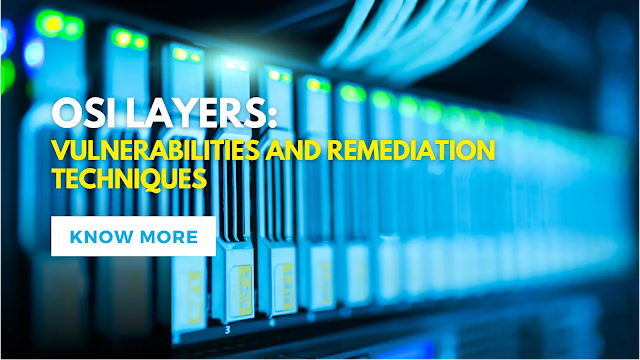What Is the OSI Model?
The OSI model consists of the following seven layers, listed from bottom to top:- Physical Layer
- Data Link Layer
- Network Layer
- Transport Layer
- Session Layer
- Presentation Layer
- Application Layer
Each layer interacts with the one above and below it, making layered security essential for modern networks.
1. Physical Layer (Hardware Infrastructure)
The Physical Layer is responsible for the transmission of raw binary data (0s and 1s) over a physical medium, such as cables, radio frequencies, or fiber optics. It defines hardware specifications including voltage levels, pin layouts, and transmission rates.
- Unauthorized access to networking equipment
- Cable tapping or signal interception
- Hardware manipulation or tampering
- Restrict access with locks and surveillance systems
- Use shielded or fiber optic cables
- Conduct regular audits and physical inspections
- Install tamper-evident devices
2. Data Link Layer (MAC Address and Switch Communications)
This layer manages direct node-to-node communication within the same local network. It handles framing, MAC addressing, error detection, and flow control, ensuring data is transferred reliably over the physical medium.
- MAC address spoofing
- ARP cache poisoning
- VLAN hopping
- Enable port security on switches
- Implement Dynamic ARP Inspection (DAI)
- Use 802.1X for port-based authentication
- Disable unused switch ports
3. Network Layer (Routing and Packet Delivery)
The Network Layer determines the best path for data to travel from the source to the destination across different networks. It uses logical addressing (IP addresses) and supports routing and packet forwarding.
Vulnerabilities*:- IP spoofing
- Malicious route injection
- ICMP-based tunneling
- Denial-of-service (DoS) attacks
- Apply firewall filtering rules and ACLs
- Enable IPsec for encrypted routing
- Deploy rate limiting and anti-DDoS tools
- Use proper router configuration and route filtering
Also read: IP Address: Classes, Ranges, and Importance
4. Transport Layer (End-to-End Data Transmission)
This layer provides end-to-end communication between devices. It ensures reliable data transmission, manages segmentation and reassembly, and performs error detection and recovery using protocols like TCP and UDP.
- SYN flood attacks
- Port scanning
- Session hijacking
- Use SYN cookies or rate limiting
- Implement Intrusion Detection/Prevention Systems (IDS/IPS)
- Disable unused ports
- Employ secure transport protocols like TLS
5. Session Layer (Session Establishment and Maintenance)
The Session Layer is responsible for establishing, maintaining, and terminating sessions between applications on different devices. It controls the dialog between two systems and manages synchronization and session recovery.
Vulnerabilities*:- Session hijacking
- Session fixation
- Reuse of session tokens
- Set strict session timeouts
- Use randomized and secure session IDs
- Apply HttpOnly and Secure cookie flags
- Implement multi-factor authentication (MFA)
6. Presentation Layer (Data Encoding and Encryption)
This layer acts as a translator between the application and the network. It is responsible for data formatting, encryption, decryption, and compression, ensuring the data sent by the application layer is readable by the receiving system.
- SSL/TLS downgrade attacks
- Use of deprecated encryption standards
- Malicious code embedded in encoded payloads
- Enforce strong encryption standards (TLS 1.3)
- Avoid weak cipher suites and outdated SSL versions
- Perform data validation and sanitation
- Use certificate pinning where appropriate
7. Application Layer (User Interface and API Interaction)
The Application Layer is the topmost layer and provides services directly to the end users or applications. It enables network access for software such as web browsers, email clients, and file transfer tools. Protocols in this layer include HTTP, FTP, SMTP, and DNS.
Vulnerabilities*:- Cross-Site Scripting (XSS)
- SQL Injection
- Cross-Site Request Forgery (CSRF)
- Unsecured APIs
- And many others..
- Follow OWASP Top 10 secure coding guidelines
- Use Web Application Firewalls (WAF)
- Protect APIs with authentication and rate limiting
- Conduct regular penetration testing and code reviews
- The OSI model helps professionals understand where threats may arise and how to systematically defend each layer.
- Modern attacks often exploit multiple layers simultaneously, so relying on a single line of defense is not enough. A layered security approach backed by proactive monitoring, proper configuration, and user awareness can significantly reduce risk.
- Cybersecurity is not a one-time fix. It requires ongoing efforts in policy, training, and technology to stay ahead of evolving threats.
*The vulnerabilities outlined above are only examples and not an exhaustive list. In particular, the Application Layer can contain hundreds of potential vulnerabilities, each requiring specific security practices and controls.
